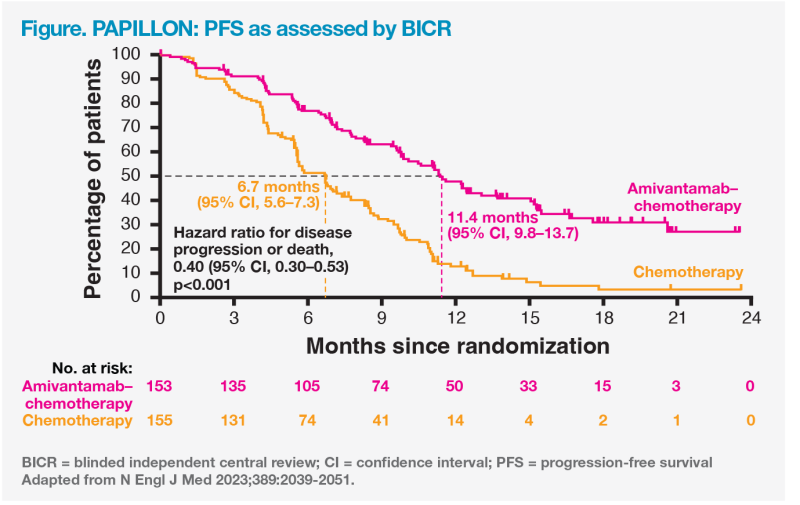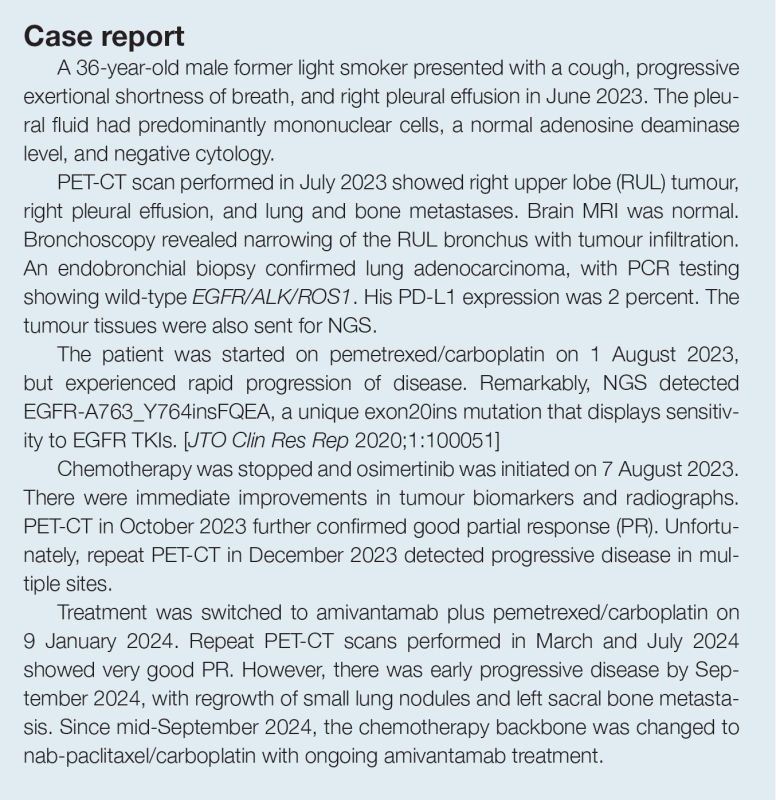Management of NSCLC harbouring EGFR exon 20 insertion mutations





Non-small-cell lung cancer (NSCLC) with EGFR exon 20 insertion (exon20ins) mutations is often resistant to approved EGFR tyrosine kinase inhibitors (TKIs). At an industry-sponsored symposium held during the 28th Congress of the Asian Pacific Society of Respirology, Dr James Ho, Specialist in Respiratory Medicine in Hong Kong, reviewed the biological properties of these mutations and the role of amivantamab, the first EGFR-MET bispecific antibody with proven efficacy in patients with metastatic NSCLC harbouring EGFR exon20ins mutations.
EGFR exon20ins mutations in NSCLC
EGFR mutations are key oncogenic drivers in NSCLC. The classical activating mutations, exon 19 deletions and exon 21 L858R substitution, account for 90 percent of all EGFR mutations and demonstrate high sensitivity to first-, second- and third-generation EGFR TKIs. [Cancer Treat Rev 2023;120:102628] Exon20ins mutations are the third most common subtype and account for 5–11.5 percent of EGFR mutations in Asian patients with NSCLC. [Curr Oncol 2022;29:2154- 2164; Thorac Cancer 2021;12:357-363]
Low sensitivity to traditional TKIs
Unlike classical EGFR mutations, exon20ins mutations (with the exception of A763_Y764insFQEA) are associated with de novo resistance to EGFR TKIs. The conformational changes caused by exon20ins mutations create steric hindrance in the drug-binding pocket, resulting in lack of affinity to traditional TKIs. [Signal Transduct Target Ther 2019;4:5]
“Over 100 unique EGFR exon20ins variants have been identified in NSCLC,” noted Ho. “This diversity of molecular variants confers varying degrees of clinical sensitivity to TKIs.” A retrospective analysis of a large population study identified 85 unique EGFR exon20ins variants in 547 cases. The majority of exon20ins variants exhibited resistance to first-, second- and third-generation EGFR TKIs, apart from A763_Y764insFQEA (frequency of 4.8 percent). [Cancer Treat Rev 2023;120:102628; Mol Oncol 2020;14:1695-1704]
Low detection rate via standard PCR assay
Identification of EGFR exon20ins mutations in patients with NSCLC is important for subsequent individualized therapy. These mutations can be detected through polymerase chain reaction (PCR) or next-generation sequencing (NGS) assays. “Conventional PCR-based assays tend to miss about 50 percent of EGFR exon20ins mutations compared with using NGS as standard method,” pointed out Ho. Therefore, sole reliance on PCR assays may result in underdiagnosis of this rare subset of patients. [J Thorac Oncol 2021;16:S208-S209]
Poor clinical outcomes vs common EGFR mutations
Several clinical studies of NSCLC patients treated with TKIs have reported shorter median progression-free survival (mPFS) and lower objective response rates (ORR) in patients harbouring exon20ins mutations than in those with common EGFR mutations (mPFS, <3.1 vs 8.3–21.4 months; ORR, <11.1 vs 56–83 percent). [Transl Lung Cancer Res 2019;8:302-316; Clin Lung Cancer Transl Cancer Res 2019;8:S23-S47]
“Real-world data also showed worse PFS and overall survival [OS] among patients with EGFR exon20ins mutations compared with the common activating mutations,” pointed out Ho. In a retrospective cohort study of 3,014 patients with advanced NSCLC (median follow-up, 34 months), patients with exon20ins mutations had a 75 percent increased risk of death vs those with common EGFR mutations (adjusted hazard ratio [adjHR], 1.75; 95 percent confidence interval [CI], 1.45–2.13; p<0.0001). With a median follow-up of 20.6 months, there was a 1.7-fold inrease in risk of disease progression or death on TKI therapy for patients with exon20ins mutations (adjHR, 2.7; 95 percent CI, 2.06–3.55]; p<0.0001). [J Thorac Oncol 2021;16:S145-S146]
Amivantamab for EGFR exon20ins-mutated NSCLC
Amivantamab is indicated in combination with carboplatin and pemetrexed for first-line treatment of adult patients with locally advanced or metastatic NSCLC with EGFR exon20ins mutations. Single-agent amivantamab is indicated for treatment of adult patients with advanced NSCLC harbouring EGFR exon20ins mutations, after failure of platinum‑based chemotherapy. [Rybrevant Hong Kong Prescribing Information, July 2024]
Amivantamab is an EGFR-MET bispecific antibody with immune cell–directing activity. “It targets a wide range of EGFR mutations, including T790M that confers resistance to first-and second-generation TKIs, as well as C797S, a common cause of resistance to osimertinib,” explained Ho. [Cancer Res 2016;76:3942-3953; Mol Cancer Ther 2020;19:2044-2056]
CHRYSALIS study: Amivantamab in second-line setting
CHRYSALIS is a phase I, open-label, dose-escalation and dose-expansion study that evaluated amivantamab in patients with metastatic or unresectable NSCLC and EGFR exon20ins mutations whose disease had progressed on platinum-based chemotherapy. Notably, 22 percent of the efficacy population (n=81) had previously treated and asymptomatic brain metastases at baseline. [J Clin Oncol 2021;39:3391-3402]
“The ORR was 40 percent and median duration of response was 11.1 months. The antitumour activity of amivantamab was demonstrated across a range of baseline characteristics and EGFR exon20ins variants,” said Ho.
An exploratory analysis was performed using data from the 114 participants in the safety population. “About a third of patients with brain metastases at baseline had progression in the brain,” reported Ho. “However, the benefits of amivantamab on ORR and survival were maintained irrespective of the presence or absence of baseline brain metastases.” (Table) [Ann Oncol 2022;33:S38- S39; Trigo J, ELCC 2022, abstract 20P]

“For patients with isolated intracranial progression, stereotactic radiosurgery can be administered to control brain lesions while continuing with amivantamab treatment,” he added. [Ann Oncol 2022;33:S38-S39]
The safety profile of amivantamab is consistent with inhibition of EGFR and MET pathways. EGFR-related toxicities included rash (86 percent), paronychia (45 percent), stomatitis (21 percent), and pruritus (17 percent). Adverse events (AEs) associated with MET inhibition included hypoalbuminaemia (27 percent) and peripheral oedema (18 percent). Infusion-related reactions occurred in 66 percent of patients, but were mostly limited to the first infusion. These can be managed by splitting the first dose over 2 days and through administration of prophylactic premedication. [J Clin Oncol 2021;39:3391-3402]
PAPILLON study: Amivantamab in first-line setting
PAPILLON is a phase III randomized trial (n=308) that assessed the efficacy and safety of amivantamab plus chemotherapy vs chemotherapy alone as first-line therapy in patients with advanced NSCLC with EGFR exon20ins. The primary endpoint was PFS by blinded independent central review (BICR). [N Engl J Med 2023;389:2039-2051]
At a median follow-up of 14.9 months, amivantamab plus chemotherapy significantly prolonged PFS vs chemotherapy alone, and resulted in a 60 percent reduction in risk of disease progression or death (mPFS, 11.4 vs 6.7 months; hazard ratio [HR], 0.40; 95 percent CI, 0.30–0.53; p<0.001). (Figure) [N Engl J Med 2023;389:2039-2051]

“The PFS benefit [favouring amivantamab plus chemotherapy] was consistent across different subgroups. Among the Asian subpopulation, the risk of disease progression or death was reduced by 66 percent [HR, 0.34; 95 percent CI, 0.23–0.49; p<0.001],” pointed out Ho. [N Engl J Med 2023;389:2039-2051; Ann Oncol 2023;34:S1668-S1669]
“Amivantamab plus chemotherapy also improved key secondary outcomes, including ORR [73 vs 47 percent; odds ratio, 3.0; 95 percent CI 1.8–4.8; p<0.001], and PFS after first subsequent therapy [PFS2, not estimable vs 17.2 months; HR, 0.49; 95 percent CI, 0.32–0.76; p=0.001],” he continued. “Thus, the benefit extends beyond the second-line setting. Interim OS analysis [33 percent maturity] showed a favourable trend for the combination vs chemotherapy alone [HR, 0.67; 95 percent CI, 0.42–1.09; p=0.106].” [Ann Oncol 2023;34:S1304]
Safety profile was consistent with that of each individual agent. The majority of AEs were grade 1 or 2 in severity. [N Engl J Med 2023;389:2039-2051]
Novel selective EGFR inhibitor in development
CLN-081 is a novel EGFR TKI with broad activity against EGFR mutations, including exon20ins, and increased selectivity for exon20ins vs wild-type EGFR. According to phase I/IIa trial data, CLN-081 elicited a confirmed partial response rate of 38.4 percent with a mPFS of 10 months in heavily pretreated patients with NSCLC with EGFR exon20ins (n=73). [Yu HA, ASCO 2022, abstract 9007]
Summary
EGFR exon20ins mutations are mostly resistant to existing EGFR TKIs, and are associated with a poor prognosis. Until recently, platinum-based chemotherapy has been the first-line treatment for NSCLC patients harbouring these mutations. Clinical studies have demonstrated the efficacy of amivantamab in combination with chemotherapy (first-line) and as monotherapy (second-line) in patients with advanced NSCLC harbouring EGFR exon20ins mutations.
